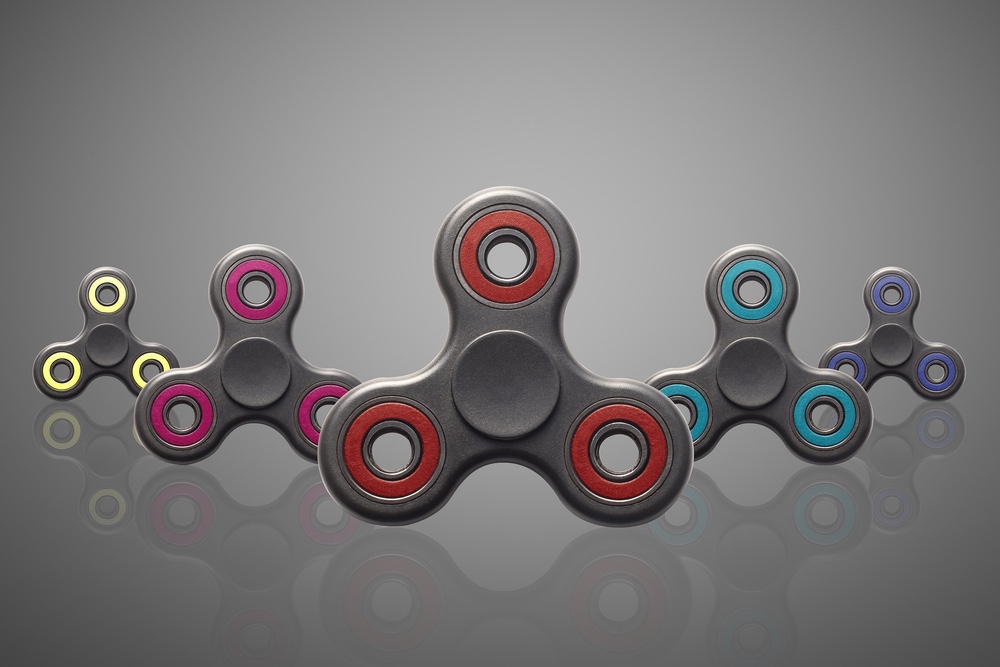How Fidget Spinners Work: It's All About the Physics

Fidget spinners ― kids spin them and spin them ― and while parents may not "get" why the boomerang-shaped toys have caught on with such force, there's real physics to explain how the distracting devices work.
"I was introduced to fidget spinners a few months ago by professor Kenneth Brecher from BU [Boston University]," said Paul Doherty, a physicist at the Exploratorium in San Francisco. "He makes his own spinning toys and handed me a fidget spinner and asked me to guess what it was. I described what it did but had no idea why someone would buy one ;-)," Doherty told Live Science in an email.
For Doherty, the spinners are interesting for another reason: "To me, these show the coolness of ball bearings that reduce friction and allow things to rotate freely for a long time." (On a basic level, friction is the resistance to motion that occurs when one object moves relative to another.) [Why Fidget Spinners Are So Hot (and Where to Buy Them)]
Here's a look at what's happening when your child, or you, balance a fidget spinner on your finger and give it a whirl.
Ball bearings are key to this spinning toy. To understand why, try this: Slide a block of wood or other material across the floor. Then do the same with a marble. "I bet the marble goes farther," Doherty said. That's because friction associated with rolling motion is typically less than so-called sliding friction.
This same principle can be applied to the spinners. At the center, and on each of the three "wings" of the spinner, is a bearing race, which is a circular channel around which tiny balls roll with low friction, Doherty said. [The Cool Physics of 7 Classic Toys]
To get any object to rotate, you need to exert a twisting force, known as torque, on it. That's where a set of little hands comes into play: "In a fidget spinner, you hold the center of one ball bearing, the outer bearing race spins around, and the outer parts of the fidget spin with the outer bearing race," Doherty said. "One flick of the fidget with a finger or a rapid twist of the wrist sets the fidget in motion, and it keeps going because of the low friction."
Get the world’s most fascinating discoveries delivered straight to your inbox.
And when it comes to spinning, shape matters. "If you put the ball bearing at the center of a disk, you must start the spin by pushing on the outer part," Doherty said, referring to the fact that the object's center of mass would be at the center. (The center of mass is the point at which you can balance an object, like the pivot point of a seesaw.)
"However, if the object has protrusions so the ball bearing is not at the center of mass, you can start it spinning with a flick of your wrist," he added. The ball bearings on the outer parts of the spinner are mainly their for weight.
To understand how this works, Doherty offered a simple example. "Think of the ball bearing at one end of a short, thick tongue depressor. Hold the bearing between your thumb and forefinger and let the depressor hang down. Move your hand forward parallel to the floor, then stop suddenly, and the stick will flip around in a circle."
You can make your own fidget spinner, albeit a bulkier version, Doherty said. Here's how he did it, and though he didn't use ball bearings, he said, it still works.
With a parent or other adult supervising:
- Cut a 1.5-inch long (nearly 4 centimeters) section off a smooth cylindrical Bic or other similar pen, with the ink insert removed.
- Drill a hole slightly larger than the pen into a half-inch PVC 4-way connector, slightly off-center.
- Slide the cylindrical pen segment into the hole.
- With the pen held between your thumb and finger, it should take just a few seconds to get the "fidget" to spin, Doherty said.
amzn_assoc_placement = "adunit0"; amzn_assoc_search_bar = "true"; amzn_assoc_tracking_id = "livescience01-20"; amzn_assoc_search_bar_position = "bottom"; amzn_assoc_ad_mode = "search"; amzn_assoc_ad_type = "smart"; amzn_assoc_marketplace = "amazon"; amzn_assoc_region = "US"; amzn_assoc_title = "Where to buy:"; amzn_assoc_default_search_phrase = "Fidget Spinner"; amzn_assoc_default_category = "All"; amzn_assoc_linkid = "02c300db4d7b6d99829c1e7eb88bbe85"; amzn_assoc_rows = "1";
(The Exploratorium has loads of other fun experiments and science-y activities like the one above.)
Original article on Live Science.
Jeanna Bryner is managing editor of Scientific American. Previously she was editor in chief of Live Science and, prior to that, an editor at Scholastic's Science World magazine. Bryner has an English degree from Salisbury University, a master's degree in biogeochemistry and environmental sciences from the University of Maryland and a graduate science journalism degree from New York University. She has worked as a biologist in Florida, where she monitored wetlands and did field surveys for endangered species, including the gorgeous Florida Scrub Jay. She also received an ocean sciences journalism fellowship from the Woods Hole Oceanographic Institution. She is a firm believer that science is for everyone and that just about everything can be viewed through the lens of science.


